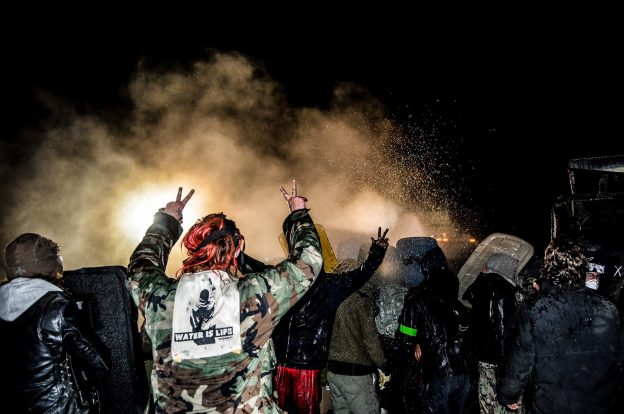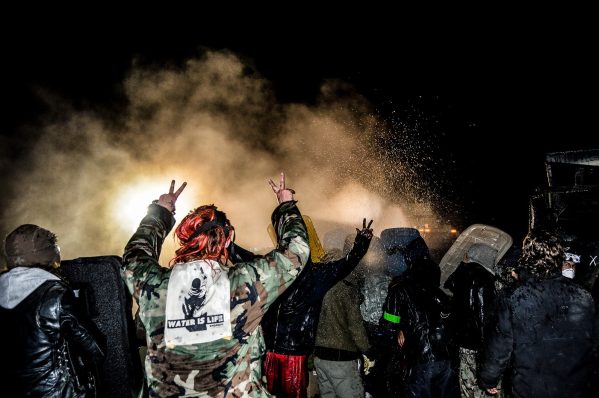
Conor Varela Handley – Water protectors were under constant surveillance and harassment from the perimeters of their camps, day and night.
‘The Intercept’ posts internal memos by TigerSwan, an international counter-terrorist military group, allegedly hired by Energy Transfer Partners
ICMN Staff • May 29, 2017
The revelations posted by the investigative-news website The Intercept on Saturday May 27 did not come as much of a surprise to water protectors who spent time on the front lines or at the camps near Standing Rock in opposition to the Dakota Access Pipeline (DAPL). In fact the allegations of intense surveillance by private contractor TigerSwan, as if water protectors were terroristic jihadists rather than peaceful, prayerful protesters upholding the right to clean water, validated the experience of those people on the ground last summer and fall.
“While in the #OcetiSakowin camps, we knew that these counter intelligence and movement disruption tactics were being used,” said Dallas Goldtooth, the Keep It in the Ground organizer for the Indigenous Environmental Network, in a statement on Facebook. “Our devices would stop working for periods of time, hard drives would be cleared of information and footage, and from time to time camp security would identify infiltrators inside the camp who were working for Energy Transfer Partners.”
Over the course of the months-long protest, thousands of people descended upon land adjacent to the Standing Rock Sioux reservation to express their support for a change in route for the DAPL so that it would not pass within a half mile of the reservation or be routed through treaty land. Met with militarized police and private security forces, they were beset by dogs, shot with water cannons in subfreezing temperatures, and bombarded by rubber bullets and concussion grenades, some of which resulted in severe injuries.
Now, based on an exhaustive review of hundreds of documents, e-mails and reports, The Intercept alleges that TigerSwan, a private security company hired by DAPL builder Energy Transfer Partners, worked closely with authorities in several states, as well as the Federal Bureau of Investigation (FBI) and other agencies, to pursue ETP’s corporate agenda. Their goal was to not only stifle opposition but also infiltrate and discredit the movement, terming it dangerously religious.
“The leaked materials not only highlight TigerSwan’s militaristic approach to protecting its client’s interests but also the company’s profit-driven imperative to portray the nonviolent water protector movement as unpredictable and menacing enough to justify the continued need for extraordinary security measures,” reported Alleen Brown, Will Parrish and Alice Speri in The Intercept. The site alleges that internal TigerSwan documents were sent by a whistleblower. The trove of internal memos includes “detailed summaries of the previous day’s surveillance targeting pipeline opponents, intelligence on upcoming protests, and information harvested from social media. The documents also provide extensive evidence of aerial surveillance and radio eavesdropping, as well as infiltration of camps and activist circles.”
TigerSwan did not respond to requests for comment from ICMN. Energy Transfer Partners issued a terse statement to a request for a response.
“The safety of our employees and the communities in which we live and work is our top priority,” wrote ETP spokesperson Vicki Granado in a statement e-mailed to ICMN. “In order to ensure that, we do have security plans in place, and we do communicate with law enforcement agencies as appropriate. Beyond that we do not discuss details of our security efforts.”
Below are ten of the most shocking allegations from The Intercept, a website founded in 2013 by journalists Glenn Greenwald, Laura Poitras and Jeremy Scahill, after they helped bring forth disclosures by Edward Snowden, the National Security Administration (NSA) whistleblower, of extensive surveillance of individuals across the U.S. The Intercept’s full report contains much more, including links to downloadable originals of several of the documents cited. In addition, the story says, more coverage is in the works.
TigerSwan portrayed NoDAPL as a religious movement, akin to a jihad.
According to The Intercept, TigerSwan went so far as to compare water protectors with fundamentalist Muslims, calling the movement “an ideologically driven insurgency with a strong religious component” and alluding to Iraq and Afghanistan in terms of tactics.
TigerSwan worked against the water protectors as if they were jihadists.
Although the water protectors were unarmed, TigerSwan used tactics more often deployed against suicide bombers and violent protesters. TigerSwan infiltrated the water protectors’ ranks, trolled social media accounts for information and conducted helicopter and drone surveillance of activity far from DAPL construction sites.
People of Middle Eastern descent at the camps were identified and tracked closely as potential links to international terrorism.
TigerSwan, according to documents obtained by The Intercept, paid special attention to water protectors of Middle Eastern descent, in particular Haithem El-Zabri, a Palestinian-American activist.
“As indigenous people, Palestinians stand in solidarity with other indigenous people and their right to land, water, and sovereignty,” a shocked El-Zabri told The Intercept. “To insinuate that our assumed faith is a red flag for terrorist tactics is another example of willful ignorance and the establishment’s continued attempts to criminalize nonviolent protest and justify violence against it.”
They shadowed people of interest, from water protectors to at least one reporter.
An inkling of this seeped out when The Guardian reported earlier this year that counterterrorism experts had attempted to contact water protectors long after they had left Standing Rock. Upon reading The Intercept’s report, water protector Kandi Mossett, also of the Indigenous Environmental Network, posted photos of an alleged bugging device that had been found in a room of the Prairie Knights Hotel and Casino on the Standing Rock Sioux reservation, where many water protectors were housed. TigerSwan was especially interested in activist Cody Hall, who was shadowed constantly and was the subject of much communication, according to the documents obtained and posted by The Intercept. And it was not lost on him.
“It was obvious—they were driving in trucks, SUVs, they would be right behind me, right next to me … it was like, damn, man, it’s like you’re getting an escort,” said Hall to The Intercept. “That was always the scary thing: How did they know that I was coming?”
The intense surveillance continued even after Hall’s September arrest and release on bail.
“In a deliberate show of force, four units surrounded my car. Each car had three to four officers to take me into custody,” Hall said in a statement last fall after spending a weekend in jail. “Their intimidation tactics continued when we arrived at the Morton County Jail. Eight officers were waiting for me when the elevator door opened.”
Security forces had infiltrators working for them.
Infiltrators, allegedly using fake names, were reported as trying to gain trust and insinuate themselves into positions of influence at the camps. The documents convey the sense that these agents reported back to TigerSwan regularly. One October 3 TigerSwan dispatch discusses ways to pit camp residents against one another along classic lines: native versus non-natives and protectors campaigning for peaceful action against those arguing for more aggressive actions. All such infiltrations were a part of “our effort to delegitimize the anti-DAPL movement.”
The effort extended beyond the water protector camps at Standing Rock, with monitoring of activity in all four states that the pipeline passes through.
The security contractor planted fake social media pushback on social media accounts.
As the U.S. was consumed by reports of “fake news,” TigerSwan put out some of its own, planting fake assertions on social media.
In keeping with the religious theme, TigerSwan saw the dispersal of the protectors as a diaspora that needs to be tracked and contained.
TigerSwan said the water protector movement had “generally followed the jihadist insurgency model while active,” and predicted that “we can expect the individuals who fought for and supported it to follow a post-insurgency model after its collapse.”
They think the NoDAPL movement has imploded, and that they were responsible.
“While we can expect to see the continued spread of the anti-DAPL diaspora … aggressive intelligence preparation of the battlefield and active coordination between intelligence and security elements are now a proven method of defeating pipeline insurgencies,” TigerSwan said in a memo quoted by The Intercept.
They refer to the water protector camps and associated movements in militaristic terms and display an unnerving level of hostility.
TigerSwan terms the camps “the battlespace” and characterizes the water protectors’ actions at DAPL construction sites as criminal and a national security threat.
They are still at it.
Even though the camps have dissipated, surveillance was still intense. As recently as May 4 an alleged internal memo “describes an effort to amass digital and ground intelligence,” The Intercept revealed.
Such revelations only corroborated the water protectors’ experience.
“Now the evidence of this is coming to bear,” said Goldtooth in his Facebook statement. “This proof also tells us more about the militarization of the police and the violence they imposed on Water Protectors. By comparing Indigenous Peoples and civilians to Jihadist Terrorists, police and security were essentially given permission to carry out war-like tactics on Water Protectors—and perpetrate ongoing suppression of peaceful voices dedicated to the defense of water.”
[SOURCE]













